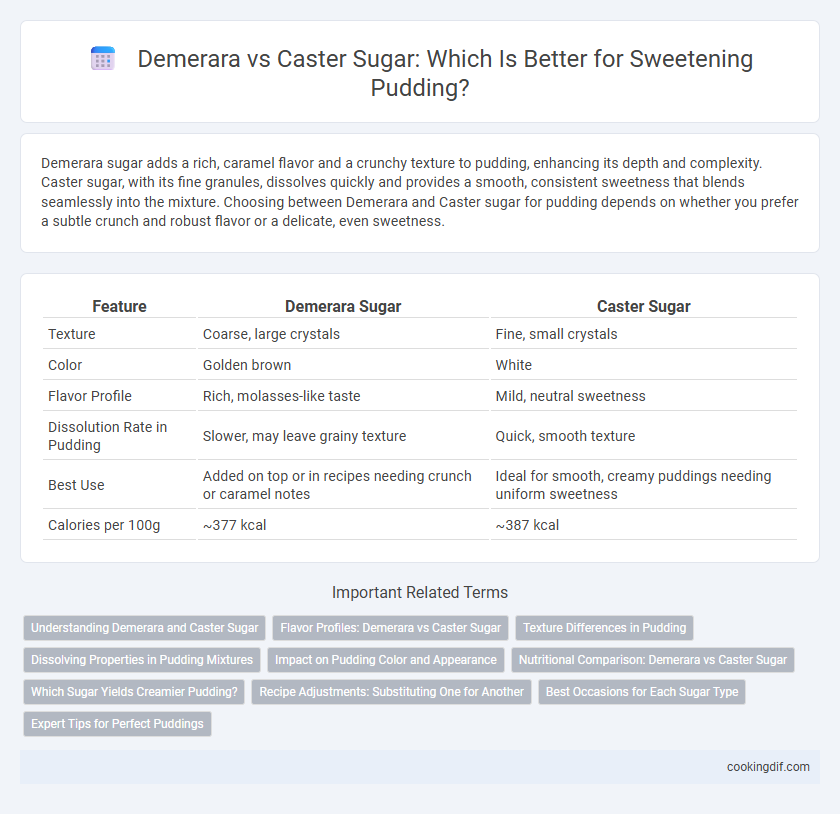Demerara sugar adds a rich, caramel flavor and a crunchy texture to pudding, enhancing its depth and complexity. Caster sugar, with its fine granules, dissolves quickly and provides a smooth, consistent sweetness that blends seamlessly into the mixture. Choosing between Demerara and Caster sugar for pudding depends on whether you prefer a subtle crunch and robust flavor or a delicate, even sweetness.
Table of Comparison
| Feature | Demerara Sugar | Caster Sugar |
|---|---|---|
| Texture | Coarse, large crystals | Fine, small crystals |
| Color | Golden brown | White |
| Flavor Profile | Rich, molasses-like taste | Mild, neutral sweetness |
| Dissolution Rate in Pudding | Slower, may leave grainy texture | Quick, smooth texture |
| Best Use | Added on top or in recipes needing crunch or caramel notes | Ideal for smooth, creamy puddings needing uniform sweetness |
| Calories per 100g | ~377 kcal | ~387 kcal |
Understanding Demerara and Caster Sugar
Demerara sugar is a minimally refined, coarse-grained sugar with large amber crystals and a rich molasses flavor, often used to add texture and depth to puddings. Caster sugar, finely ground with a light texture, dissolves quickly, providing a smooth, consistent sweetness ideal for creamy puddings. Understanding the distinct crystal sizes and flavor profiles of Demerara and Caster sugar helps in choosing the right sweetener to enhance pudding texture and taste.
Flavor Profiles: Demerara vs Caster Sugar
Demerara sugar imparts a rich, caramel-like flavor with subtle molasses notes that enhance the depth of pudding recipes, creating a more complex and toasty sweetness. Caster sugar, finely ground and with a clean, neutral sweetness, dissolves quickly, providing a smooth texture without altering the pudding's flavor profile. Choosing Demerara results in a more robust, earthy sweetness, while Caster sugar offers a delicate, pure sweetness ideal for light, creamy puddings.
Texture Differences in Pudding
Demerara sugar adds a coarser texture to pudding due to its larger crystals, creating a slight crunch that contrasts with the smoothness of the dessert. Caster sugar, with its fine granules, dissolves more quickly and evenly, resulting in a creamier and silkier pudding consistency. Choosing between these sugars affects not only sweetness but also the pudding's mouthfeel, influencing the overall sensory experience.
Dissolving Properties in Pudding Mixtures
Demerara sugar has larger, coarser crystals that dissolve more slowly in pudding mixtures, potentially leading to a grainy texture if not fully dissolved. Caster sugar features finer granules that dissolve quickly and evenly, ensuring a smoother, more consistent pudding texture. For optimal dissolution and creamy results, caster sugar is typically preferred in pudding recipes.
Impact on Pudding Color and Appearance
Demerara sugar imparts a rich amber hue and a slightly grainy texture to pudding, enhancing its rustic appearance. Caster sugar dissolves more readily, resulting in a smoother texture and a paler, creamier color in the final pudding. Choosing between Demerara and Caster sugar significantly influences the pudding's visual appeal and mouthfeel.
Nutritional Comparison: Demerara vs Caster Sugar
Demerara sugar contains slightly more minerals like calcium, potassium, and iron due to its minimal processing, while caster sugar is highly refined and primarily provides pure sucrose with negligible nutrients. Both sugars have similar calorie content, but demarara's larger crystals contribute to a lower glycemic index compared to caster sugar's fine texture. Choosing demarara sugar for pudding may add subtle mineral benefits and a richer flavor without significantly altering calorie intake.
Which Sugar Yields Creamier Pudding?
Demerara sugar, with its coarse texture and large molasses crystals, imparts a richer, caramel-like flavor but may result in a grainier pudding texture. Caster sugar, finely ground and dissolving quickly, ensures a smoother, creamier consistency in puddings by evenly sweetening without residual grittiness. For achieving the creamiest pudding, caster sugar is generally preferred due to its superior solubility and subtle flavor profile.
Recipe Adjustments: Substituting One for Another
When substituting Demerara sugar for Caster sugar in pudding recipes, adjust the texture by slightly reducing the sugar quantity due to Demerara's larger crystals and richer molasses flavor. Caster sugar dissolves more quickly, so increase mixing time or gently heat the mixture to ensure even sweetness distribution with Demerara. Recipes may require moisture adjustments, as Demerara's coarse grains can affect the pudding's consistency and tenderness compared to the finer Caster sugar.
Best Occasions for Each Sugar Type
Demerara sugar, with its coarse texture and rich molasses flavor, is ideal for recipes that benefit from a crunchy topping or robust caramel notes, such as baked puddings and fruit crumbles. Caster sugar, finely ground and quick to dissolve, works best in smooth, creamy puddings or delicate custards where a uniform sweetness without graininess is essential. Choosing between these sugars depends on whether the pudding calls for a textured finish or a seamlessly sweet base.
Expert Tips for Perfect Puddings
Demerara sugar, with its coarse texture and rich molasses flavor, adds a caramelized depth ideal for custard-based puddings, enhancing both taste and appearance. Caster sugar's fine grains dissolve quickly, ensuring a smooth, even sweetness perfect for light, airy puddings like mousse or sponge. Expert tips recommend choosing Demerara for robust flavors requiring caramelization, while caster sugar is best for delicate textures and consistent sweetness.
Demerara vs Caster sugar for sweetener Infographic

 cookingdif.com
cookingdif.com